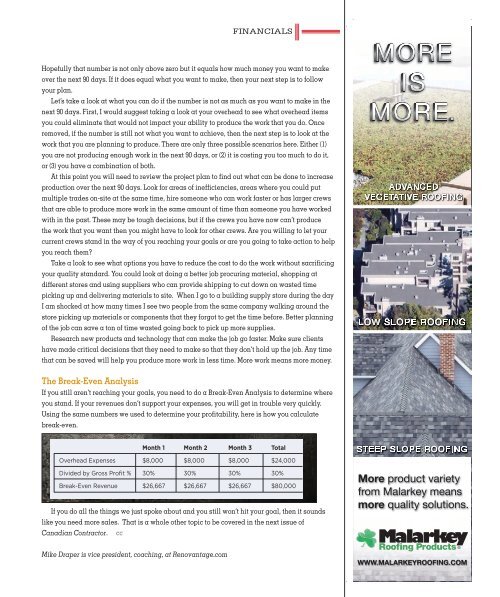Canadian Contractor - July-August 2015
Create successful ePaper yourself
Turn your PDF publications into a flip-book with our unique Google optimized e-Paper software.
FINANCIALS<br />
Hopefully that number is not only above zero but it equals how much money you want to make<br />
over the next 90 days. If it does equal what you want to make, then your next step is to follow<br />
your plan.<br />
Let’s take a look at what you can do if the number is not as much as you want to make in the<br />
next 90 days. First, I would suggest taking a look at your overhead to see what overhead items<br />
you could eliminate that would not impact your ability to produce the work that you do. Once<br />
removed, if the number is still not what you want to achieve, then the next step is to look at the<br />
work that you are planning to produce. There are only three possible scenarios here. Either (1)<br />
you are not producing enough work in the next 90 days, or (2) it is costing you too much to do it,<br />
or (3) you have a combination of both.<br />
At this point you will need to review the project plan to find out what can be done to increase<br />
production over the next 90 days. Look for areas of inefficiencies, areas where you could put<br />
multiple trades on-site at the same time, hire someone who can work faster or has larger crews<br />
that are able to produce more work in the same amount of time than someone you have worked<br />
with in the past. These may be tough decisions, but if the crews you have now can’t produce<br />
the work that you want then you might have to look for other crews. Are you willing to let your<br />
current crews stand in the way of you reaching your goals or are you going to take action to help<br />
you reach them?<br />
Take a look to see what options you have to reduce the cost to do the work without sacrificing<br />
your quality standard. You could look at doing a better job procuring material, shopping at<br />
different stores and using suppliers who can provide shipping to cut down on wasted time<br />
picking up and delivering materials to site. When I go to a building supply store during the day<br />
I am shocked at how many times I see two people from the same company walking around the<br />
store picking up materials or components that they forgot to get the time before. Better planning<br />
of the job can save a ton of time wasted going back to pick up more supplies.<br />
Research new products and technology that can make the job go faster. Make sure clients<br />
have made critical decisions that they need to make so that they don’t hold up the job. Any time<br />
that can be saved will help you produce more work in less time. More work means more money.<br />
The Break-Even Analysis<br />
If you still aren’t reaching your goals, you need to do a Break-Even Analysis to determine where<br />
you stand. If your revenues don’t support your expenses, you will get in trouble very quickly.<br />
Using the same numbers we used to determine your profitability, here is how you calculate<br />
break-even.<br />
Month 1 Month 2 Month 3 Total<br />
Overhead Expenses $8,000 $8,000 $8,000 $24,000<br />
Divided by Gross Profit % 30% 30% 30% 30%<br />
Break-Even Revenue $26,667 $26,667 $26,667 $80,000<br />
If you do all the things we just spoke about and you still won’t hit your goal, then it sounds<br />
like you need more sales. That is a whole other topic to be covered in the next issue of<br />
<strong>Canadian</strong> <strong>Contractor</strong>. cc<br />
Mike Draper is vice president, coaching, at Renovantage.com

















